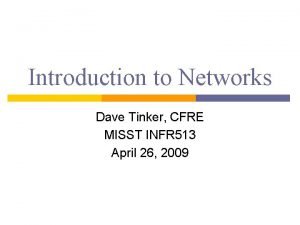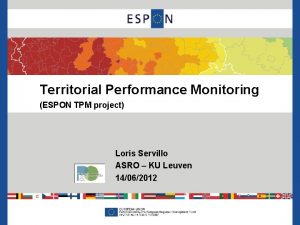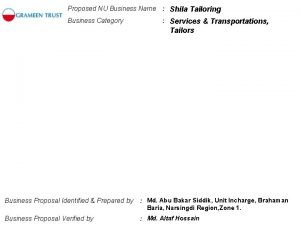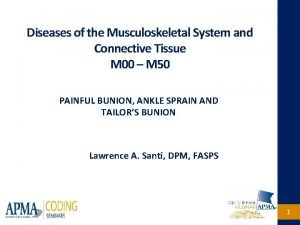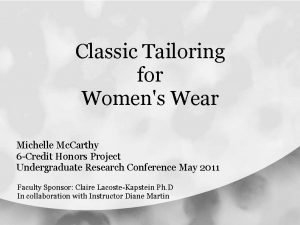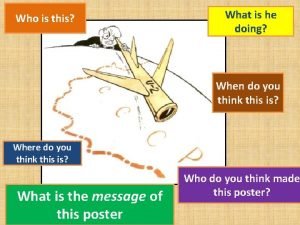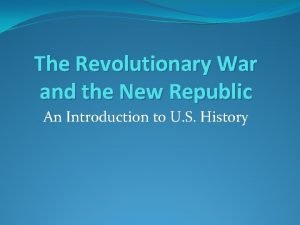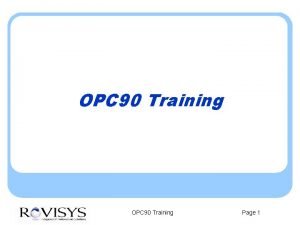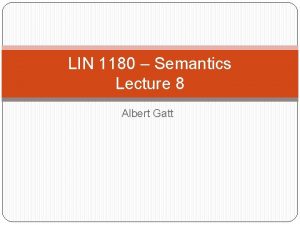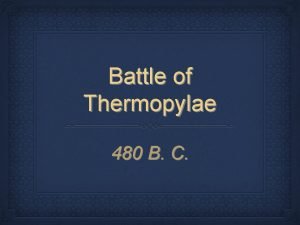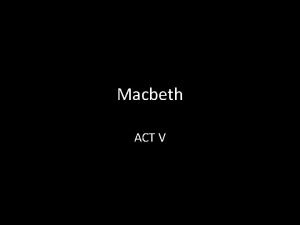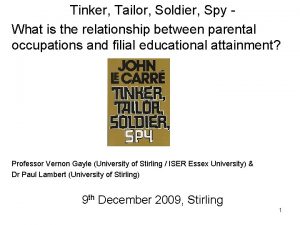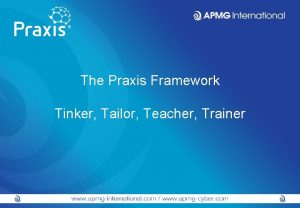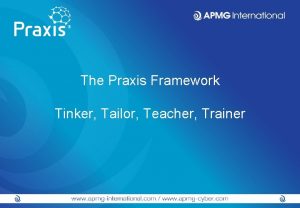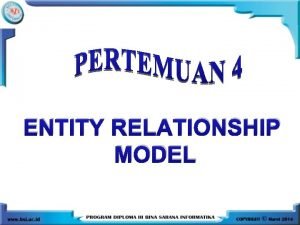Tinker Tailor Soldier Spy What is the relationship




















































- Slides: 52

Tinker, Tailor, Soldier, Spy What is the relationship between parental occupations and filial educational attainment? Professor Vernon Gayle (University of Stirling / ISER Essex University) & Dr Paul Lambert (University of Stirling) 9 th December 2009, Stirling 1

BEWARE! WORK IN PROGRESS Mainly exploratory analyses The title is a play on the spy novel by John le Carré first published in 1974. Pseudonym of David John Moore Cornwell, who taught French and German at Eton before joining MI 5. The novel’s title is from the children’s nursery rhyme ‘tinker, tailor, soldier, sailor, rich man, poor man, beggar man thief’ which are the code names of the five men suspected as being the mole in MI 5. The BBC adapted the novel for TV in 1979 with Alec Guinness playing the lead. As a small boy I watched it with my legs crossed for an entire episode! 2

The overall motivation… • Undertake a piece of work that locates within a wider sociological perspectives on social stratification – ‘inter’-generational relationships • A long running empirical research theme within the sociology of education and the sociology of youth has been the relationship between parental social background (often measured by parental occupation) and educational attainment • Historically the weight of evidence has indicated that educational attainment is stratified - typically, those from more advantaged social backgrounds generally achieve higher levels of attainment than their counterparts from less advantaged backgrounds • An attempt to use some recently harmonised large-scale survey data – augment analyses with additional measures • Begin to examine the effects of missing data (item non-response) • Start to think about future analyses 3

Structure of Talk • The sociology of education – Introduction to GCSEs • The national data • Youth Cohort Study of England & Wales • Descriptive results – GCSE attainment measures – Parental occupational measures • Modelling Results – A closer look at parental occupations • Missing data & multiple imputations – A first attempt • Conclusions • Further work (if time) 4

General Certificate of Education • General Certificate of Secondary Education (GCSE) introduced in the late 1980 s • The standard qualification for pupils in England Wales in year 11 (aged 15/16) • Usually a mixture of assessed coursework and examinations • Generally each subject is assessed separately and a subject specific GCSE awarded • It is usual for pupils to study for about nine subjects, which will include core subjects (e. g. English, Maths and Science) and non-core subjects • GCSEs are graded in discrete ordered categories • The highest being A*, followed by grades A through to G • Arran Fernandez gained A* in Maths at age 8 ! (A* from 1994) 5

General Certificate of Education • The Education Reform Act 1988 led to rapid changes in the secondary school curriculum, and to the organisation, management and financing of schools • A major change for pupils was the introduction of the General Certificate of Secondary Education (GCSE) • GCSEs differed from the qualifications that they replaced – A new grading scheme was established and all pupils were entered for a common set of examinations – There were also changes in the content and format of examinations and assessment by coursework was introduced • School league tables were published • A newsworthy item each summer – Previously only teachers, parents and pupils knew when exam day was 6

Why explore GCSE attainment? • GCSEs are public examinations and mark the first major branching point in a young person’s educational career • Poor GCSE attainment is a considerable obstacle which precludes young people from pursuing more advanced educational courses • Young people with low levels of GCSE attainment are usually more likely to leave education at the minimum school leaving age and their qualification level frequently disadvantages them in the labour market • Low levels of qualifications are also likely to have a longer term impact on experiences in the adult labour market • Therefore, I argue that gaps in GCSE attainment are sociologically important 7

Department for Education and Skills (2007) Gender and Education: The evidence on pupils in England 8

Year All pupils Boys Girls % % % 1990 34. 5 30. 8 38. 4 1991 36. 8 33. 3 40. 3 1992 38. 3 34. 1 42. 7 Percentage aged 15 on roll in all English schools 1993 41. 2 36. 8 45. 8 Figures 1998 onwards are for GCSE & GNVQ equivalent 1994 43. 3 39. 1 47. 8 1995 43. 5 39. 0 48. 1 1996 44. 5 39. 9 49. 4 1997 45. 1 40. 5 50. 0 1998 46. 3 41. 3 51. 5 1999 47. 9 42. 8 53. 4 2000 49. 2 44. 0 54. 6 2001 50. 0 44. 8 55. 4 2002 51. 6 46. 4 57. 0 2003 52. 9 47. 9 58. 2 2004 53. 7 48. 4 58. 4 2005 56. 3 51. 4 61. 4 2006 58. 5 53. 8 63. 5 Data Sources Df. E&E; Df. ES; Df. CSF 2007 60. 3 55. 8 65. 0 Table 1 http: //www. bstubbs. co. uk/5 a-c. htm#table 1 2008 65. 3 60. 9 69. 9 National Figures, % of pupils gaining 5+ GCSEs (grades A*-C) 9

Youth Cohort Study of England & Wales (YCS) • Major Longitudinal Study began Mid-1980 s • Designed to monitor behaviour of young people as they reach the minimum school leaving age and either stay on in education of enter the labour market • Experiences of Education (qualifications); Employment; Training; Aspirations; Family; Personal characteristic & circumstances • Nationally representative; Large sample size; Panel data (albeit short); Possible to compare cohorts (trends over time) • Study contacts a sample from an academic year group (cohort) in the spring following completion of compulsory education • The sample is designed to be representative of all Year 11 pupils in England & Wales • Sample are tracked for 3 (sometimes 4) waves (called Sweeps) of data collection • Growing up in the 1990 s the GCSE era; Partly fills the gap left by the missing 198(2) birth cohort 10

Working with the YCS • Documentation is very poor especially in the older cohorts – usually handwritten annotation on questionnaires (pdf) (Compare this with the BHPS for example) • Changes in qualifications, educational policy etc adds data complications • Changes is questions, measures, coding, timing etc, all add to the general confusion • Recently available harmonized dataset SN 5765 Title: Youth Cohort Time Series for England, Wales and Scotland, 1984 -2002 Depositor(s): Croxford, L. , University of Edinburgh. Centre for Educational Sociology Principal Investigator(s): Croxford, L. , University of Edinburgh. Centre for Educational Sociology Iannelli, C. , University of Edinburgh. Centre for Educational Sociology Shapira, M. , University of Edinburgh. Centre for Educational Sociology Economic and Social Research Council Grant Number: R 000239852 11

Official and YCS Surveys % of pupils gaining 5+ GCSEs (grades A*-C) All Pupils YCS Pupils Boys Official Boys YCS Girls Official Girls YCS 1990 34. 5 35. 1 30. 8 31. 6 38. 4 38. 7 1993 41. 2 42. 3 36. 8 38. 1 45. 8 46. 7 1995 43. 5 44. 9 39. 0 40. 6 48. 1 49. 3 1997 45. 1 46. 2 40. 5 41. 9 50. 0 50. 6 1999 47. 9 51. 0 42. 8 46. 4 53. 4 55. 7 Year YCS Data Source: Dataset SN 5765 (weighted data) 12

Why parental occupation • Occupations is a key measure of social stratification • Maps onto wider sociological conception of social class • Why not income or wealth? – 16/17 year olds are being questioned – fluctuation in income and wealth – parents’ location on the age/income distribution • Occupation is a proxy – – lifetime income life chances (and opportunities) life style & consumption patterns (even correlates with health) 13

A proxy for income? In this respect, we would argue that the use of socioeconomic classifications in research is not simply to act as a proxy for income where income data themselves are unavailable. We use socio-economic classifications because they are measures designed to help us identify key forms of social relations to which income is merely epiphenomenal… It is also the case that socio-economic classifications are relatively more general and stable measures than income. Income is well known to fluctuate over the lifecourse; indeed panel data regularly reveals a high level of ‘income churning’ from year to year (for the UK see Jarvis and Jenkins 1997). What socio-economic classifications might reasonably be expected to proxy is the lifecourse/earnings profile. (Rose and Pevalin 2003) A Researcher’s Guide to the National Statistics Socio-economic Classification 14

Which measure of occupation? Forty years ago, Bechhofer’s review of the use of occupational information in sociology bemoaned the abundance of, and inconsistencies between, occupationally based social classifications, noting that “. . researchers are advised not to add to the already existing plethora of classifications without very good reason” (1969 p. 118) However since that recommendation, the number of new classifications has increased steadily We argue for the transparent use of classifications that have ‘agreed’ standards of measurement and can therefore be replicated and compared within and across analyses 15

• Various (unsystematic) parental occupation measures deposited with individual YCS cohorts • NS-SEC (8 and 3 category) deposited with SN 5765 • RGSC, CAMSIS & Elias not in SN 5765 – Derived from data using GEODE Resources – www. geode. stir. ac. uk – www. dames. org. uk/ • Simple dominance method – common in stratification research – father or mother whichever is higher on the relevant scheme • nurse mum and consultant dad = dad • nurse mum and hospital porter dad = mum 16

Brief illustration of parental occupational measures • National Statistics Socio-economic Classification (NS-SEC) – – – Official classification From 2001 used in all official statistics Some Govt statisticians only speak NS-SEC Various versions – below is 8 category Not ordered categories ! 1. 1 Large employers & higher professionals 1. 2 Higher Professionals 2 Lower managerial & professional 3 Intermediate occupations 4 Small employers & own account 5 Lower supervisory & technical 6 Semi-routine occupations 7 Routine occupations 17

Brief illustration of parental occupational measures • Registrar General’s Social Class (RGSC) – Official classification until 2001 – Ordered categorical measure Professional (I) Intermediate (II) Skilled Non-Manual (IIIn) Skilled Manual (IIIm) Partly Skilled (IV) Unskilled (V) 18

Brief illustration of parental occupational measures • CAMSIS: Social Interaction and Stratification Scale – www. camsis. stir. ac. uk/ – Scale empirically derived from patterns of social interaction Continuous scale with mean=50 s. d. =15 19

Brief illustration of parental occupational measures • Elias’ Skill Classification Managerial & Professional Middle Working Elementary 20

Simplified Illustration* Job NS-SEC RGSC Company Director Marketing (25+ employees) Large employer & higher managers Intermediate (II) 66 Judge Higher professional Professional (I) 86 Nurse Lower professional Intermediate (II) 52 (59 female) Draughtsperson Intermediate Skilled Non-Manual (IIIn) 59 Bricklayer (self employed) Small employer & own account Skilled Manual (IIIm) 37 Painter & decorator (supervisor) Lower supervisory & technical Skilled Manual (IIIm) 40 Tyre fitter Semi-routine Partly Skilled (IV) 42 Road Sweeper Routine Unskilled (V) 32 * Does not include Elias’ skill measure CAMSIS (male) 21

YCS Data • YCS cohorts – School leaving years 1990, 1993, 1995, 1997, 1999 • Comprehensive school pupils – Free schooling – No educational selection • Complete information on parental occupation and other measures (n=55120) 22

GCSE Outcome Measures • 5+ GCSEs grades A*-C – – Recognised official bench mark Frequently used outcome measure in research School league table measure This measure is still published annually by The Department for Children, Schools and Families (see http: //www. dcsf. gov. uk/performancetables/ ) – Government target is 53% with 5+A*-C including Maths & English by 2011 • Number of GCSEs grades A*-C • GCSE score (A/A*=7; G=1) – Capped at 84 point 12 GCSEs Grade A/A* • Standardized GCSE score (A/A*=7; G=1) 23

Descriptive Results (Table 1) • Overall trend – Increasing proportions getting 5+GCSEs (A*-C) – Increasing mean number of A*-C grade GCSEs – Increasing mean GCSE points score • Gender – Female pupils outperforming male pupils • Ethnicity – Some groups doing better than white pupils (e. g. Indians) – Other groups doing worse (e. g. blacks) • Parental Occupation – Observable gradient – Lower levels of GCSE attainment from those pupils with less occupationally advantaged parents 24

Figure 1 25

Figure 3 26

Figure 4 27

Modelling Results (Tables 2 - 5) Models (survey regression models) – – Logit 5+GCSEs (A*-C) Negative binomial (count) number of A*-C grade GCSEs Regression GCSE points score (standardised across cohorts mean=0 s. d. =1) • Gender – Female pupils outperforming male pupils • Ethnicity – Some groups doing better than white pupils (e. g. Indians) – Other groups doing worse (e. g. blacks) • Parental Occupation – Lower levels of GCSE attainment from those pupils with 28 less occupationally advantaged parents whatever measure

Survey Regression model Year 11 GCSE score (all 1990 s Cohorts) Model fit summary statistics Adjusted R 2 BIC Cohort + gender + ethnicity . 08 465195 + NS-SEC 8 Cat . 20 457438 + NS-SEC 3 Cat . 18 458613 + RGSC . 19 457986 + Camsis . 21 456761 + Elias’ Skill . 17 459082 29

Exploring at Occupational Unit Group (OUG) Level NS-SEC No. of SOC 90 Occupations* 1. 1 Large Employers and higher managers 1. 2 Higher professional occupations 2 Lower managerial and professional occupations 3 Intermediate occupations 5 Lower supervisory and technical occupations 6 Semi-routine occupations 7 Routine occupations Total 10 38 78 42 41 88 74 371 * Employees Possible interesting variations within NS-SEC categories 30

Figure 5 31

Figure 6 32

Figure 7 33

Mc. Knight & Elias (1998) Guide to the 371 Database Earnings distributions in SOC OUG ‘quindeciles? ’ Distribution of employment by (highest) qualification SOC OUG Further thinking required here… 34

Item non-response • Parental occupation information is an important factor in GCSE attainment • Remember… in the YCS young people aged 17 being asked about their parents • NS-SEC 7, 835 pupils with missing data (12%) • Promising results from a paper at RC 33 Nobel et al. 2008 reported an experiment with LSYPE cohort testing pupils with YCS question and interviewing their 35 parents

Item non-response • Over 60% of young people correctly reported their parents’ occupation at 4 digit OUG (disappointingly only approx. 74% get it at 1 digit level) – – Unit group 2111 Chemists Minor group 211 Natural scientists Sub major group 21 Science and engineering professionals Major group 2 Professional occupations • Nobel et al. 2008 reported no significant social class pattern to the errors (using NS-SEC)! 36

Missing data & Multiple imputation number missing GCSE Score 1135 NS-SEC (3 Categories) 7835 Ethnicity 1064 Gender Cohort 0 0 37

Patterns of Missing Values Y NS-SEC Ethnicity + +. . . +. +. +. . Missing Vars 0 1 1 2 3 2 n 55145 6821 697 592 352 318 104 16 38

Creation of Multiple Imputed Datasets Imputation by chained equations (ice in Stata) • Regression model GCSE Score • Ologit model of NS-SEC (3 Categories) • Mlogit model of Ethnicity • 10 imputed datasets – 20 cycles of regression switching 39

Analysis of Multiple Imputed Datasets • Stata mim prefix to combine the results from the 10 different imputed data sets into a single output • The promise of a (combined) analysis of datasets with 64045 pupils rather than 55145 pupils (complete cases) 40

Complete Cases Analysis Beta s. e. Model of Multiple Imputed Datasets Beta s. e. FMI NS-SEC (3 Classes) Managerial & Professional 0. 00 Intermediate Occupations -7. 46 0. 15 -7. 67 0. 15 0. 09 -13. 85 0. 17 -14. 51 0. 17 0. 10 39. 70 0. 19 39. 05 0. 18 0. 06 Routine Occupations Constant n 0. 00 55145 64045 The promise of a (combined) analysis of datasets with 64045 pupils rather than 55145 pupils (complete cases) Substantive inference on NS-SEC appears similar…. Table 7 41

Complete Cases Analysis Beta Whites s. e. 0. 00 Model of Multiple Imputed Datasets Beta s. e. FMI 0. 00 Black -5. 62 0. 57 -7. 31 0. 50 0. 10 Indian 3. 60 0. 44 3. 08 0. 41 0. 04 -1. 89 0. 58 -3. 61 0. 48 0. 15 Bangladeshi 0. 42 1. 04 -3. 44 0. 75 0. 21 Other Asians 5. 36 0. 68 4. 65 0. 63 0. 07 Other Groups -0. 36 0. 70 -1. 43 0. 64 0. 06 Pakistani n 55145 64045 The larger the value of FMI, the greater the loss of information (hence loss of precision) that has been induced in the estimated coefficient by the missing data. The substantive inference is altered for Pakistani and Bangladeshi pupils & those within the other ethnic group… 42

Analysis of Multiple Imputed Datasets • This might be an important first step – The negative effects of being Pakistani or Bangladeshi are potentially being underestimated in the complete case analysis 43

What is the relationship between parental occupations and filial educational attainment? • Relatively strong (and persistent) association between a pupil’s GCSE attainment and the occupations of their parents (net of cohort, gender and ethnicity) – Similar association with any GCSE measure – Similar association with any of the occupational based measures (e. g. NS-SEC, RGSC, Camsis, Elias Skill) • The level of association is stronger than gender and ethnicity – The parental occupational gap is more striking – Ongoing concern about the gender gap • In educational circles and in public discourse (media fuelled) • Contribution to wider debates within stratification research 44

Further Comments • Labour Government want to ‘break the link between a child’s background and their chances of success’ (Df. CSF 2009) • Evidence is presented in a confused fashion • Concepts are mixed up – Family income; Free School Meals; Social Class Working class; Disadvantaged; Deprived ? ? 45

Some Methodological Thoughts • More sophisticated modelling of missing data – e. g. imputation from more comprehensive statistical models – Weighted survey data beyond Stata at present • Variation within socio-econ classifications – this requires more exploration 46

The Future is Brighter (But not necessarily for me at age 42…) Still heavily constrained by data resources The LSYPE is promising so are the newer birth cohorts UKHLS – Estimated 1, 000 new births per year – – – Synthetic cohorts of school leavers Individual data (as early as rising 10 year olds) Linked (official) educational data Household data Income data Parental data (step-parents) Consider what will be possible in 25 years time? 47

48

The Sociology of Education Some studies that I was taught about when I was an undergraduate Willis, P. (1977) Learning to Labour: How working class kids get working class jobs Ethnographic study in West Midlands Corrigan, P. (1979) Schooling the Smash Street Kids Study of working class boys in Sunderland Lacey, C. (1970) Hightown Grammar – The school as a social system Study of a northern grammar school. A study of the ‘disappointing performance of working class boys in grammar schools since the 1944 Education Act’ (p. xi) Rutter, M. et al. (1979) Fifteen Thousand Hours – Secondary schools and their effects on children 15, 000 hours the average time spent at school, a study of 12 inner London schools 2, 000 pupils tracked though secondary school Douglas, J. W. B. (1964) The Home and the School: A study of ability and attainment in the primary school Douglas, J. W. B. (1970) All our futures Studies of the 1946 birth cohort Rosenthal, R. and Jacobson, L. (1968) Pygmalion in the Classroom Californian study – falsely informed teachers that a randomly selected 20% of pupils were gifted They had pre and post intervention measures and noted that this group showed greater improvements in reading A study that I have recently read Wedge, P. and Prosser, H. (1973) Born to Fail? Children’s Bureau report on the striking differences in the lives of British children A more recent example Devine, F. (2004) Class Practices – How parents help their children get good jobs A qualitative study of middle class parents in Britain and America 49

Models with Occupational Unit Group (OUG) Level Linear regression with a large dummy-variable set n areg 55120 lsdv 55120 R 2 Adjusted R 2 0. 234 0. 229 454889. 53 458907. 08 BIC Identical parameter estimates and standard errors for cohorts, gender and ethnicity factors areg is more parsimonious The areg approach might be useful when parental occupation (at a very detailed level) is a control to be modelled rather than explicitly a variable of interest? 50

2000 – 5+ GCSE Passes (A*-C) England 49% Essex LEA 51% Colchester High School 82% Alderman Blaxill School 31% My old comprehensive 25% 51

1997 School Performance Tables – Examples of schools attended by notable social survey analysts Name Type England Year 11 n - % 5 A*-C % 5 A*-G - 45 84 St Bede’s Redhill VA Comp Mixed 11 -18 245 69 96 St David's & St Katherine's (C of E) VA Comp Mixed 11 -18 187 14 70 Westcliffe High School for Boys GM Selective Boys 11 -18 130 96 97 52 http: //www. dcsf. gov. uk/performancetables/archives/schools_97. shtml
 Spy components
Spy components What are the miranda rights
What are the miranda rights V
V Tinker vs des moines school district
Tinker vs des moines school district Tinker v des moines conclusion
Tinker v des moines conclusion Tinker v des moines outcome
Tinker v des moines outcome Tinker v des moines quote
Tinker v des moines quote Tinker v des moines impact
Tinker v des moines impact Tinker cad.com
Tinker cad.com Tinker
Tinker Tinker vs des moines facts
Tinker vs des moines facts Tinker creek meaning in malayalam
Tinker creek meaning in malayalam Loris servillo
Loris servillo Ablv
Ablv Costume in sign language
Costume in sign language Tailoring business proposal
Tailoring business proposal Tailor's bunion icd 10
Tailor's bunion icd 10 Tailor
Tailor Challenger teach tailor take control
Challenger teach tailor take control Mc tailoring
Mc tailoring The tailor of swaffham
The tailor of swaffham Modern tailor
Modern tailor Tailor pci
Tailor pci Unece
Unece Mrc scale
Mrc scale The imperialist tailor
The imperialist tailor Deepa tailor lawyer
Deepa tailor lawyer Spy - card party game взлом
Spy - card party game взлом They say he is spy rewrite in the other voice
They say he is spy rewrite in the other voice Eric franklin rosser
Eric franklin rosser I spy simple machines
I spy simple machines Spy addon
Spy addon U2 spy plane cartoon
U2 spy plane cartoon Spionage tools
Spionage tools Spy aware
Spy aware Si spy net work, big fedjaw iog link kyxogy
Si spy net work, big fedjaw iog link kyxogy I spy creator
I spy creator Fin spy
Fin spy Robert townsend
Robert townsend Opc data spy
Opc data spy Customer relationship mangement
Customer relationship mangement Hyponymy
Hyponymy The soldier decided to desert his dessert in the desert
The soldier decided to desert his dessert in the desert A+b=b+a is called
A+b=b+a is called Theme of dulce et decorum est
Theme of dulce et decorum est Marie little soldier montana 1948
Marie little soldier montana 1948 Lina mayfleet character traits
Lina mayfleet character traits Thermopylae a soldier's humor
Thermopylae a soldier's humor Roman recruitment poster
Roman recruitment poster English bond t junction elevation
English bond t junction elevation Macduff's reaction to his family's death
Macduff's reaction to his family's death Soldier christian
Soldier christian Vik muniz toy soldier
Vik muniz toy soldier









